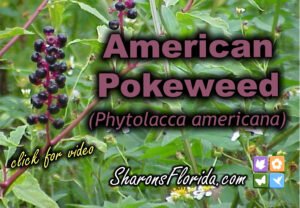Phytolacca americana
(Pokeweed)
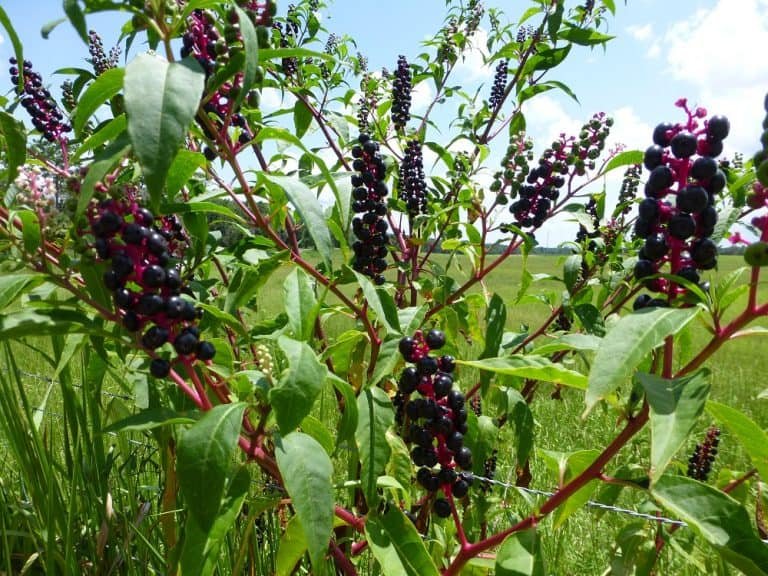
Common Names, Latin Name and Family
It has many common names including pokeweed, American pokeweed, poke salad, poke sallet, pokeberry, inkberry, poke, pocan, coakum, Virginia poke, poke root, scoke, pigeon berry, garget, cancer jalep, and chui xu shang lu (in Chinese medicine).
Its Latin name is Phytolacca americana.
It is in the Phytolaccaceae, or pokeweed, family.
The botanical genus, Phytolacca, is derived from the Greek word, phyton, meaning “plant” and the Latin, lacca, meaning “lacquer.”
The English name, pokeweed, is believed to be a derivative of the Native American words, pocan, referring to any plant yielding a red dye, and pak, meaning “blood.”
Form
Pokeweed is a large perennial shrub and can grow to a height of approximately 15 feet and just about as wide.
The mature plant is usually multi-trunked, but may grow as a single stalk.
The stems are a brilliant purple color.
Leaves
The leaves are alternate, with petioles, oblong to lance shaped and tapering at both ends.
The stems and stalks become red as the plant matures.
Flowers
The flowers are small and lack petals, however the sepals resemble petals and are white, tinted pink along the edges and the center is green.
They are found on racemes that are from 2 to 8 inches in length.
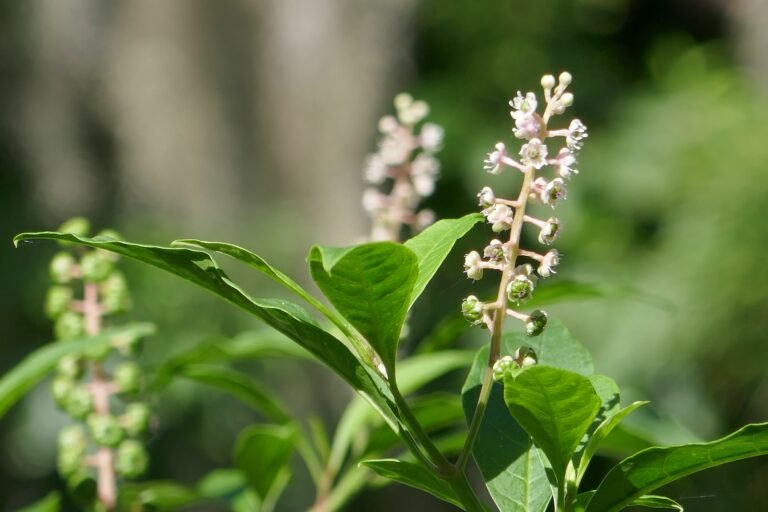
Fruit
Once the flowers are pollinated the fruit begins to form. At first the fruit is tiny and green and still has the sepals attached and then once it ripens and turns dark purple the sepals fall off.
The fruit stains anything it touches and can be used as a natural plant dye so keep that in mind when dealing with the berries.
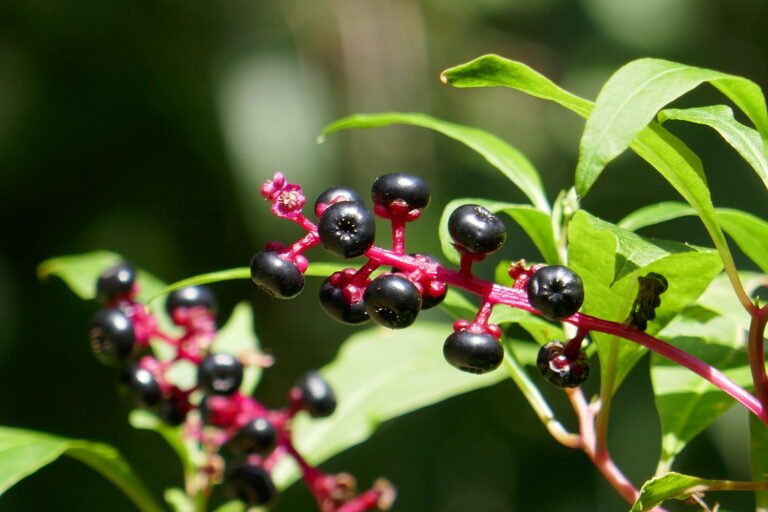
Habitat
Pokeweed occurs naturally in disturbed sites, fence rows, thickets, roadsides, fields, and disturbed sites.
Native Range
It is native to the eastern Unites States and is found from Maine to Florida to Texas.
Landscape Use
Pokeweed will grow in just about any soil with dry to moist soils in full sun. It does not do well in shade and even part shade may keep it from flowering very much. It is completely zero maintenance once established.
It is quite striking in the landscape with its bright red stems and stalks, white flowers and deep purple berries. It is rather large and will not do in a tidy flowerbed and is probably used best along the edge of a woodland area or as a specimen planting. The stalks are brittle and larger specimens should be staked to prevent collapse during heavy rains, and or the weight of the berries and birds. A large plant of mine is tied to a fence and is staked well enough to withstand the weight of a pileated woodpecker that stops by to eat berries once a week or so.
Pokeweed will freeze to the ground each year, but will come back from the roots in the spring. The plant will freeze and turn brown but if there are any fruit left on it should be allowed to remain until the birds consume the remainder. It may not look very attractive, but during the winter the dried pokeberries are an important food source for birds. The dead stalks can be removed once all the berries have been consumed or as the new growth appears from the root in the spring.
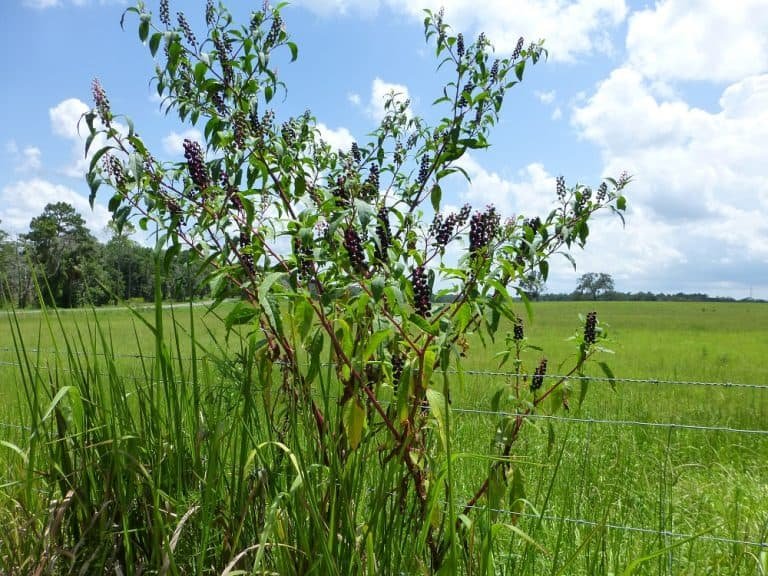
Wildlife Use
Keep it out of your pastures and away from your livestock because it is poisonous to them!
The flowers attract many pollinators, and consequently attract insect eating birds. Flower production is at its peak in the spring and summer, however, flowers occur long into the fall when the plant is covered with maturing fruit.
Though pokeweed is considered a nuisance weed by many I consider it an amazing plant. It is an incredible source of food for a wide variety of wildlife. The flowers provide a nectar source for bees, wasps, and butterflies, and the fruit and flower buds provide a food source for a variety of birds. Foxes, opossums, raccoons, and field mice also eat the fruit. It is by far the most frequently visited shrub in my landscape and property. Wildlife of all sorts can be seen at any given time reaping the benefits the pokeweed provides. The cardinals in my yard visit it daily to eat flower buds and fruit, and the Carolina wrens scour it for insects.
I am always happy to have this free plant in my landscape; it requires no maintenance; comes back year after year without replanting or seeding; provides the wildlife a food source all year long, and is always a source of entertainment for the wildlife watcher and photographer that I am.
The vegetation is also a larval food for the southern army moth (Persectania ewingii).

Human Use
Pokeweed has a long history of use as food, medicine, and dye for cloth.
Pokeweed was utilized by the First Nations of North America as a purgative, emetic and anti-rheumatic, and it was officially listed in the United States Pharmacopoeia from 1820 to 1916 as an analgesic and anti-inflammatory. It has also played a long and important role in herbal medicine as a treatment for cancer and is, in fact, one of the constituents in the Hoxsey Formula (unapproved by the orthodox medical community) for the management of many types of cancer … As an antiviral, pokeweed (or pokeroot) has an unusual chemistry.
“Pokeweed antiviral protein (PAP) from Phytolacca americana is a ribosome inactivating protein (RIP) and is an RNA N-glycosidase that removes specific purine residues from the sarcin/ricin (S/R) loop of large rRNA, arresting protein synthesis at the translocation step. PAP is thought to play an important role in the plant’s defense mechanism against foreign pathogens. This review focuses on the structure, function, and the relationship of PAP to other RIPs, discusses molecular aspects of PAP antiviral activity, the novel inhibition of this plant toxin by a virus counteraction—a peptide linked to the viral genome (VPg), and possible applications of RIP-conjugated immunotoxins in cancer therapeutics.” [1]
Pokeweed is toxic to horses and cattle. All parts of the plant are considered poisonous although many people eat, cooked, immature green shoots when they are 4 -6 inches tall. Recipes call for boiling the immature stems and leaves in several changes of water. The plant becomes more toxic as it matures and the stem becomes reddish purple.
Propagation
It is easy to grow from seed or transplanting volunteers.
Transplanting is the best for instant gratification, however seeds will propagate easily … or you can look for volunteer seedlings left by the birds along fencerows. I certainly can’t ask much more of a plant … I don’t have to buy it, pamper it, feed it, or even water it.
It transplants well at any size however the flowers and fruit need to be removed so it can recover from the shock and focus on keeping its root alive. If it does die back to the ground be patient as it will most likely send up new shoots very quickly.
The root is a large, brownish, bulb that resembles a sweet potato.
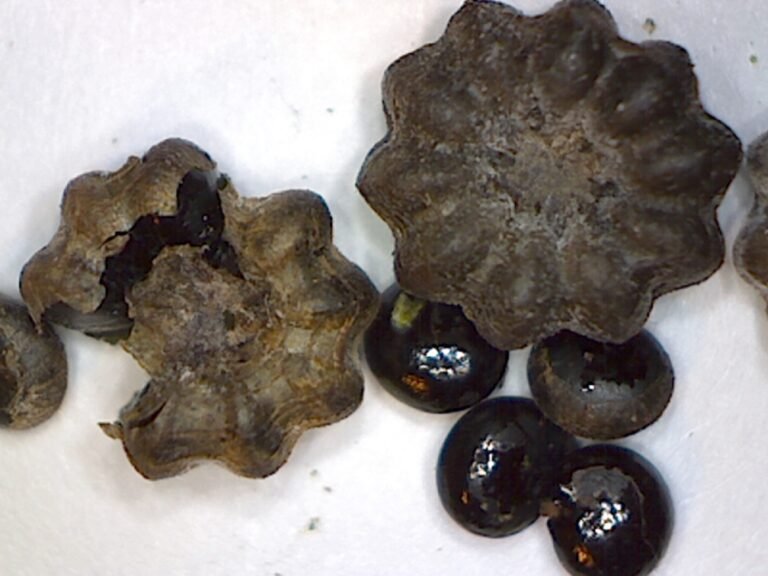
Footnote
Next Article: Rouge Plant

